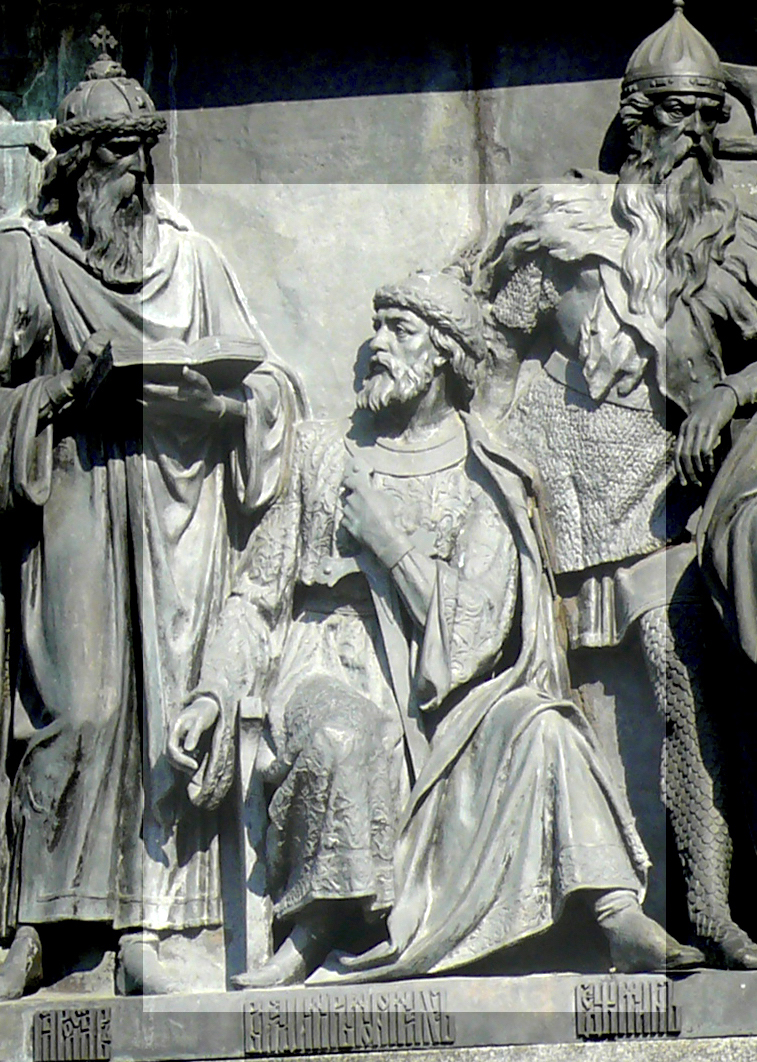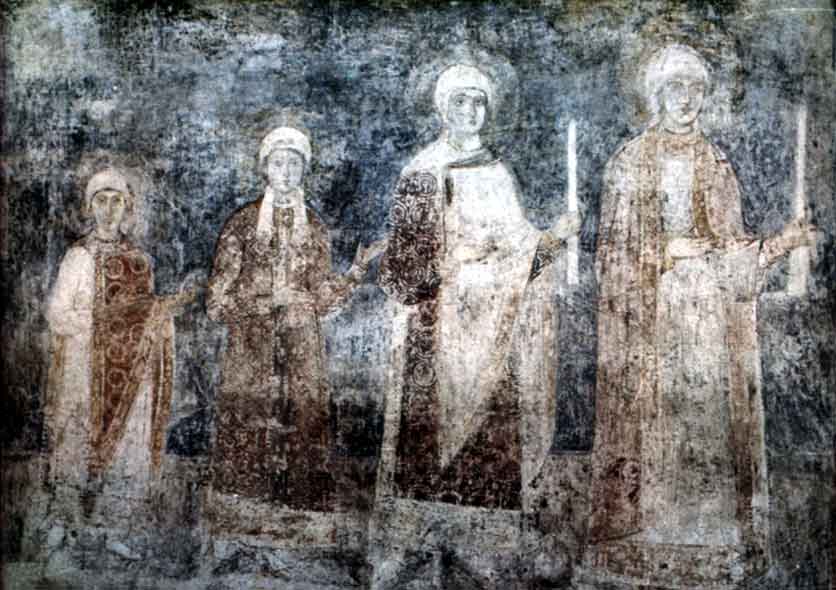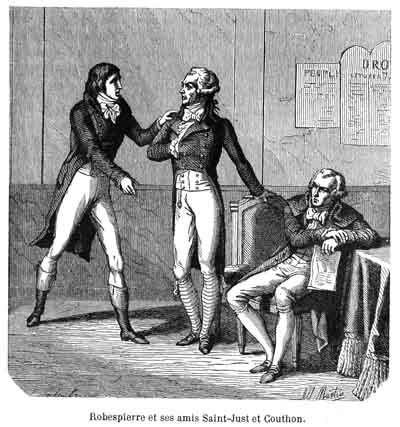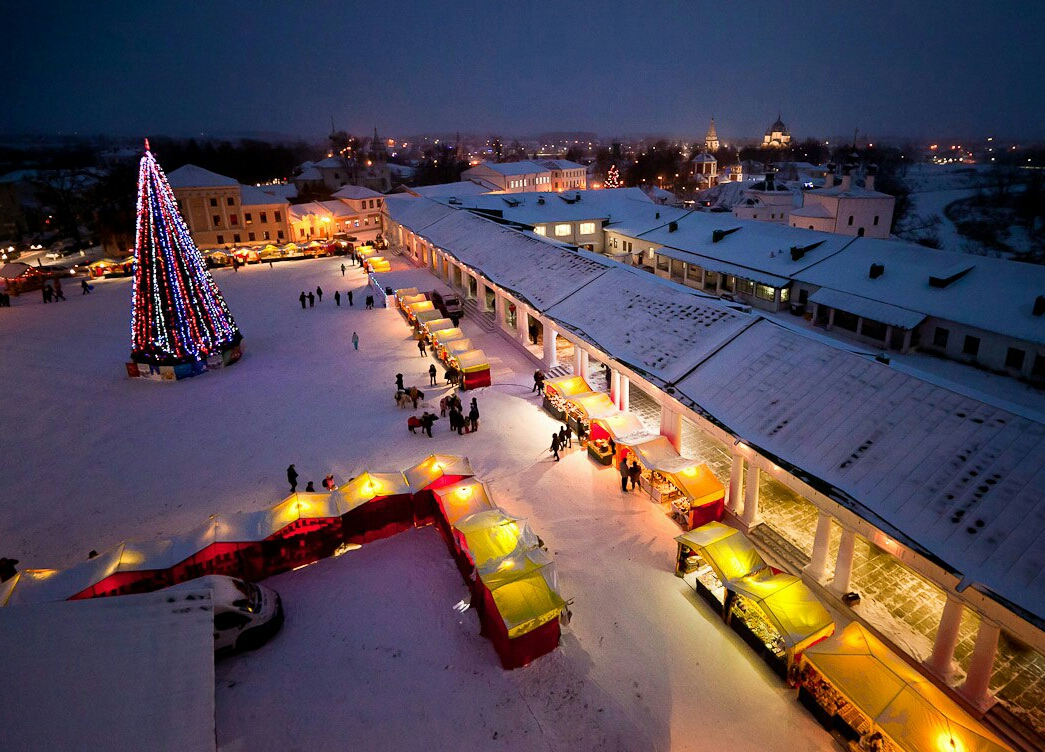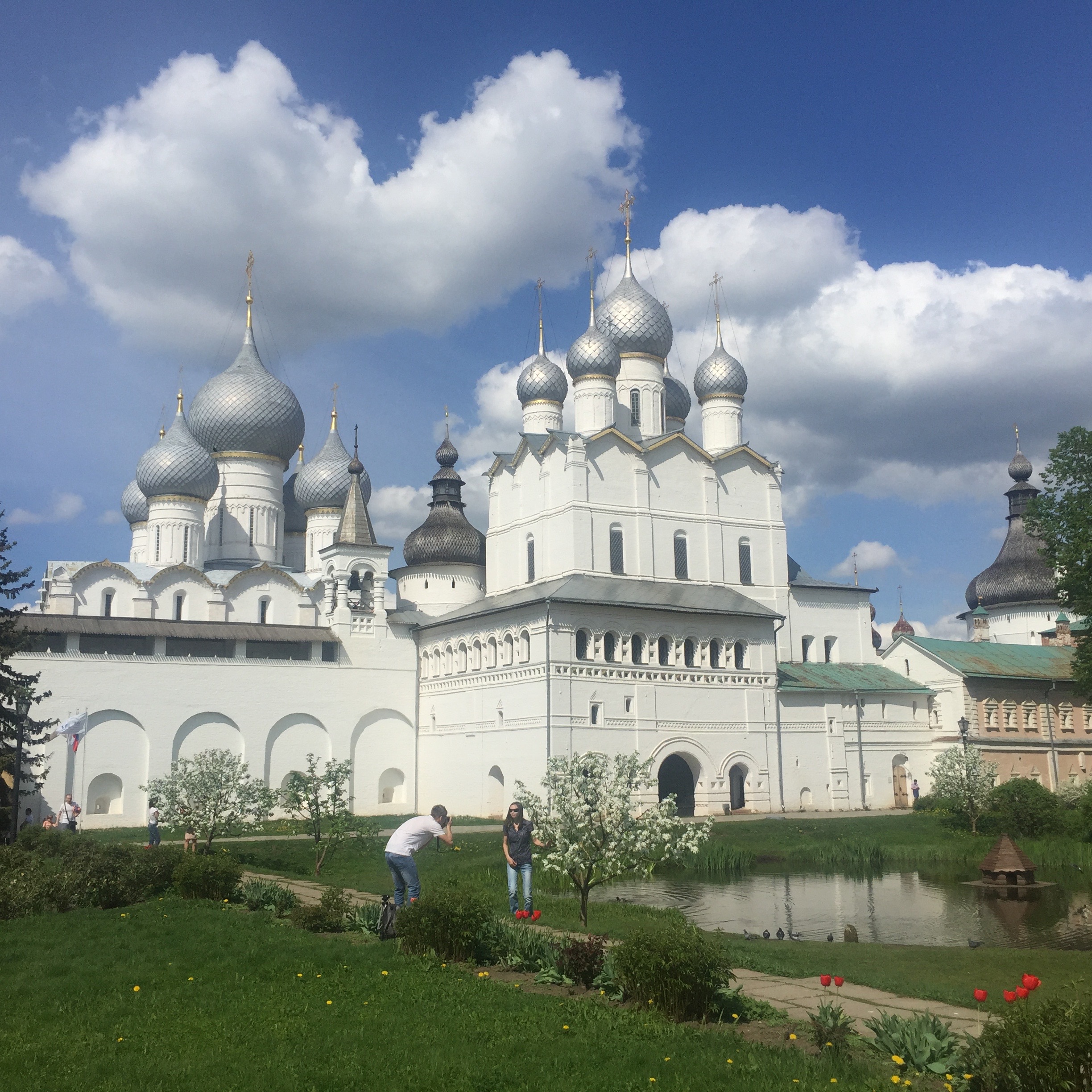|
Vsevolod I Of Kiev
Vsevolod I Yaroslavich (; – 13 April 1093) was Grand Prince of Kiev from 1078 until his death in 1093. Early life He was the fifth and favourite son of Yaroslav I the Wise by Ingigerd Olafsdottir. He was born around 1030. On his seal from his last years, he was named "Andrei Vsevolodu" in Greek, implying that his baptismal name was Andrew. To back up an armistice signed with the Byzantine Emperor Constantine IX Monomachos in 1046, his father married Vsevolod to a Byzantine princess, who according to tradition was named Anastasia or Maria. That the couple's son Vladimir Monomakh bore the family name of the Byzantine emperor suggests she was a member of his close family, but no contemporary evidence attests to a specific relationship and accounts of the Emperor give him no such daughter. Upon his father's death in 1054, he received in appanage the towns of Pereyaslav, Rostov, Suzdal, and the township of Beloozero which would remain in possession of his descendants ... [...More Info...] [...Related Items...] OR: [Wikipedia] [Google] [Baidu] |
Tsarsky Titulyarnik
The '' Tsarsky titulyarnik'' (), sometimes translated as Tsar's Book of Titles, in full the Big State Book or Root of Russian Sovereigns (), is a 1672 illuminated manuscript containing portraits of List of Russian monarchs, Russian monarchs. It was issued by Alexis of Russia and produced under the direction of Artamon Matveyev, the head of the ''posolsky prikaz'' (Ministry of Foreign Affairs (Russia), foreign ministry). It also includes short biographies and illustrations of coats of arms, as well as portraits of foreign rulers. Gallery File:00 Tsarskiy titulyarnik page.jpg, Title page of copy in Hermitage Museum File:01 Tsarskiy titulyarnik.jpg, Coat of arms of Russia File:Aleksey titularnik.jpg, Portrait of Alexis of Russia File:Joasaphus II from Tsarsky titulyarnik.jpg, Portrait of Patriarch Joasaphus II of Moscow File:Titulyarnik - Louis XIV.png, Portrait of Louis XIV References {{reflist Russian heraldry Alexis of Russia 17th-century illuminated manuscripts ... [...More Info...] [...Related Items...] OR: [Wikipedia] [Google] [Baidu] |
Yaroslav I The Wise
Yaroslav I Vladimirovich ( 978 – 20 February 1054), better known as Yaroslav the Wise, was Grand Prince of Kiev from 1019 until his death in 1054. He was also earlier Prince of Novgorod from 1010 to 1034 and Prince of Rostov from 987 to 1010, uniting the principalities for a time. Yaroslav's baptismal name was George after Saint George. Yaroslav was a son of Vladimir the Great and Rogneda of Polotsk. Yaroslav ruled the northern lands around Rostov before being transferred to Novgorod in 1010. He had a strained relationship with his father and refused to pay tribute to Kiev in 1014. Following Vladimir's death in 1015, Yaroslav waged a complicated war for the Kievan throne against his half-brother Sviatopolk, ultimately emerging victorious in 1019. As the Grand Prince of Kiev, Yaroslav focused on foreign policy, forming alliances with Scandinavian countries and weakening Byzantine influence on Kiev. He successfully captured the area around present-day Tartu, Estonia, establi ... [...More Info...] [...Related Items...] OR: [Wikipedia] [Google] [Baidu] |
Russkaya Pravda
The ''Russkaya Pravda'' (sometimes translated as ''Rus' Justice'', ''Rus' Truth'', or ''Russian Justice'') was the legal code of Kievan Rus' and its principalities during the period of feudal fragmentation. It was written at the beginning of the 12th century and remade during many centuries. The basis of the ''Russkaya Pravda'', the ''Pravda'' of Yaroslav, was written at the beginning of the 11th century. The ''Russkaya Pravda'' was a main source of the law of Kievan Rus'. In spite of great influence of Byzantine legislation on the contemporary world, and in spite of great cultural and commercial ties between Byzantium and Kievan Rus', the ''Russkaya Pravda'' bore no similarity whatsoever to the law of the Byzantine Empire. The absence of capital and corporal punishment rather reflects Norse jurisprudence. Editions Three recensions of the ''Russkaya Pravda'' are known: the Short Edition (''Kratkaya Pravda''), the Extensive Edition (''Prostrannaya Pravda''), and the Abridge ... [...More Info...] [...Related Items...] OR: [Wikipedia] [Google] [Baidu] |
Polovtsy
The Cumans or Kumans were a Turkic people, Turkic nomadic people from Central Asia comprising the western branch of the Cumania, Cuman–Kipchak confederation who spoke the Cuman language. They are referred to as Polovtsians (''Polovtsy'') in Rus' chronicles, as "Cumans" in Western sources, and as "Kipchaks" in Eastern sources. Related to the Pecheneg, they inhabited a shifting area north of the Black Sea and along the Volga River known as Cumania, from which the Cuman–Kipchaks meddled in the politics of the Caucasus and the Khwarazmian Empire. The Cumans were fierce and formidable nomadic warriors of the Eurasian Steppe who exerted an enduring influence on the medieval Balkans. They were numerous, culturally sophisticated, and militarily powerful. Many eventually settled west of the Black Sea, influencing the politics of Kievan Rus', the Kingdom of Galicia–Volhynia, Galicia–Volhynia Principality, the Golden Horde Khanate, the Second Bulgarian Empire, the Kingdom of Serbia ... [...More Info...] [...Related Items...] OR: [Wikipedia] [Google] [Baidu] |
Steppe
In physical geography, a steppe () is an ecoregion characterized by grassland plains without closed forests except near rivers and lakes. Steppe biomes may include: * the montane grasslands and shrublands biome * the tropical and subtropical grasslands, savannas, and shrublands biome * the temperate grasslands, savannas, and shrublands biome A steppe is usually covered with grass and shrubs, depending on the season and latitude. The term ''steppe climate'' denotes a semi-arid climate, which is encountered in regions too dry to support a forest, but not dry enough to be a desert. Steppes are usually characterized by a semi-arid or continental climate. Temperature extremes can be recorded in the summer of up to and in winter of down to . Besides this major seasonal difference, fluctuations between day and night are also significant: in both the highlands of Mongolia and northern Nevada, can be reached during the day with sub-freezing readings at night. Steppes ave ... [...More Info...] [...Related Items...] OR: [Wikipedia] [Google] [Baidu] |
Triumvirate
A triumvirate () or a triarchy is a political institution ruled or dominated by three individuals, known as triumvirs (). The arrangement can be formal or informal. Though the three leaders in a triumvirate are notionally equal, the actual distribution of power may vary. The term can also be used to describe a state with three different military leaders who all claim to be the sole leader. Informally, the term "triumvirate" may be used for any association of three. Under the influence of the Soviet Union, the term troika (Russian: for "group of three") may be used for "triumvirate". Pre-modern triumvirates Biblical In the Bible, triumvirates occurred at some notable events in both the Hebrew Bible (Old Testament) and New Testament. In the Book of Exodus, Moses, his brother Aaron and their nephew or brother-in-law, Hur, acted this way during the Battle of Refidim against the Amalekites. Later in Exodus 24, when Moses was away on Mount Sinai, Aaron and Hur were left in ch ... [...More Info...] [...Related Items...] OR: [Wikipedia] [Google] [Baidu] |
Middle Age
Middle age (or middle adulthood) is the age range of the years halfway between childhood and old age. The exact range is subject to public debate, but the term is commonly used to denote the age range from 45 to 65 years. Overall This time span is generally referred to as "middle age" and can be defined as the time of ages about 40–45 to about 60–65. Many changes may occur between young adulthood and this stage. There is no universal consensus on what the exact definition of middle age is, but usual characteristics include the beginning of rapid decline of fertility, graying of hair, and other physical changes. Those in middle age continue to develop relationships and adapt to changes in relationships. Such changes are highly evident in the maturing relationships between growing or grown children and aging parents. Community involvement is fairly typical of this stage of adulthood, as is continued career development. Physical characteristics Middle-aged adults may begin t ... [...More Info...] [...Related Items...] OR: [Wikipedia] [Google] [Baidu] |
Beloozero
Belozersk (), known as Beloozero () until 1777, is a town and the administrative center of Belozersky District in Vologda Oblast, Russia, located on the southern bank of Lake Beloye, from which it takes the name, northwest of Vologda, the administrative center of the oblast. Population: History Known as ''Beloozero'' () until 1777, it was first mentioned in the ''Primary Chronicle'' (PVL) in 862 along with several other towns that later became part of Kievan Rus', such as Murom, Novgorod, Polotsk, and Rostov. The PVL claims that Rurik's brother Sineus became the prince of Beloozero in 862. However, Sineus and the other brother Truvor most likely never existed. On several occasions, the settlement was moved from one bank of the lake to another. In the 11th century, the region was still inhabited primarily by Finnic peoples tribes who fiercely resisted Christianization, one of which was known as the ''белозерции''. In 1071, local pagan priests rose in rebellion, whi ... [...More Info...] [...Related Items...] OR: [Wikipedia] [Google] [Baidu] |
Suzdal
Suzdal (, ) is a Types of inhabited localities in Russia, town that serves as the administrative center of Suzdalsky District in Vladimir Oblast, Russia, which is located along the Kamenka tributary of the Nerl (Klyazma), Nerl River, north of the city of Vladimir, Russia, Vladimir. As of the Russian Census (2021), 2021 Census, its population was 9,286. In the 12th century, Suzdal became the capital of the principality. Currently, Suzdal is the smallest of the Russian Golden Ring of Russia, Golden Ring towns. It has several sites listed as World Heritage Site, UNESCO World Heritage Sites. History The town's history dates back to 999 and 1024. In 1125 Yuri Dolgorukiy, Yury Dolgoruky made Suzdal the capital of the Vladimir-Suzdal#Rostov-Suzdal, Rostov-Suzdal principality. In 1157, Andrey Bogolyubsky, Andrei Bogolyubsky moved the capital from Suzdal to Vladimir, from which time the principality was known as Vladimir-Suzdal. Suzdal was burned and plundered in 1237 during the Mo ... [...More Info...] [...Related Items...] OR: [Wikipedia] [Google] [Baidu] |
Rostov, Yaroslavl Oblast
Rostov Veliky ( rus, Ростов Великий, p=rɐˈstof vʲɪˈlʲikʲɪj, ''Rostov the Great'') is a types of inhabited localities in Russia, town in Yaroslavl Oblast, Russia, one of the oldest in the country and a tourist center of the Golden Ring of Russia, Golden Ring. It is located on the shores of Lake Nero, northeast of Moscow. Population: The name of the town was officially changed to Rostov Veliky in December 2024. The name of the town railway station is Rostov-Yaroslavsky railway station, Rostov Yaroslavsky , due to its location in Yaroslavl Oblast. History Rostov was preceded by Sarskoye Gorodishche, which some scholars interpret as the capital of the Volga Finns, Finnic Merya people, Merya tribe, while others believe it was an important Viking trade enclave and fortress guarding the Volga trade route. It is known from Norse sources as or . Scythians also settled there. These different ethnicities, such as the Vikings, Scyths, Slavs and Finns, were likely th ... [...More Info...] [...Related Items...] OR: [Wikipedia] [Google] [Baidu] |
Pereiaslav
Pereiaslav is a historical town in Boryspil Raion, Kyiv Oblast, central Ukraine. It is located near the confluence of the Alta and Trubizh rivers some southeast of the capital Kyiv. It was one of the key regional centers of power during the Middle Ages and served as the capital of a principality. Pereiaslav hosts the administration of Pereiaslav urban hromada, one of the hromadas of Ukraine. Its population is approximately Possessing more than 20 museums, Pereiaslav is often described as a "living museum","Pereyaslav Khmelnytsky – a town of museums", ''Welcome to Ukraine'' magazine, March 2007 and was granted the status of . Etymology Current name The current name is implemented by the Verkhovna Rada on 30 September 2019 to reinstate its historical name. The name of Pereiaslav in other languages are: * , (also rendered as Pereyaslav) * * * * * Former names * Pereiaslav (907 – 1943; also known as Pereiaslav-Ruskyi starting from 1152) * Pereiaslav-Khmelnyt ... [...More Info...] [...Related Items...] OR: [Wikipedia] [Google] [Baidu] |
Constantine IX Monomachos
Constantine IX Monomachos (; 980/ 1000 – 11 January 1055) reigned as Byzantine emperor from June 1042 to January 1055. Empress Zoë Porphyrogenita chose him as a husband and co-emperor in 1042, although he had been exiled for conspiring against her previous husband, Emperor Michael IV the Paphlagonian. The couple shared the throne with Zoë's sister Theodora Porphyrogenita. Zoë died in 1050, and Constantine continued his collaboration with Theodora until his own death five years later. Constantine's reign was marked by prodigality, enjoying an abundant imperial treasury following the conquests of his predecessors and the era of economic expansion that the Empire experienced in the first half of the 11th century. While Zoe was deprived of access to this treasure by Romanus III and then Michael IV, her third husband ensured that she could enjoy it as much as she wanted. He also distributed a large number of gifts, both in monetary forms and through donations of land or tax ... [...More Info...] [...Related Items...] OR: [Wikipedia] [Google] [Baidu] |
